Glassnode: BTC drops to 89,000, risk aversion remains strong in the options market
Original Title: Below the Band
Original Authors: Chris Beamish, CryptoVizArt, Antoine Colpaert, Glassnode
Translated by: Jinse Finance
Key Points of This Article:
• Bitcoin has fallen below the STH (Short-Term Holder) cost basis and the -1 STD (standard deviation) range, putting pressure on recent buyers; the $95,000 to $97,000 area has now become a key resistance zone. If this area can be reclaimed, it would mark an early step in restoring market structure.
• Spot demand remains weak, with US spot ETF inflows deeply negative, and TradFi asset allocators have not increased any buying.
• Speculative leverage continues to decline, reflected in the drop in open interest for the top 500 assets' futures and funding rates falling to cycle lows.
• The options market has significantly repriced risk, with implied volatility rising across all tenors and skew remaining very low, as traders pay high premiums for downside protection.
• Key strike prices (such as 90K) are dominated by put option flows and demand, reinforcing defensive positioning strategies. Traders are more actively hedging rather than increasing upside risk exposure.
• DVOL has returned to monthly highs, tying together the broad repricing of risk across volatility, skew, and flow indicators, and signaling expectations of increased volatility in the near term.
Bitcoin has broken below its previous consolidation range, falling below $97,000 and briefly touching $89,000, setting a new local low and turning its year-to-date gains negative. This deeper decline extends the mild bearish trend we highlighted last week and raises questions about whether structural support will re-emerge. In this issue, we will use on-chain pricing models and realized losses among short-term holders to assess the market's reaction to this drop. We will then analyze options, ETF flows, and futures positioning to evaluate how speculators are adjusting sentiment amid this new wave of weakness.
On-Chain Insights
Breaking the Lower Band
Falling below $97,000, the lower limit of last week's "chop range," signals the risk of a deeper correction. The price then plunged to $89,000, forming a new local low, below the -1 standard deviation level (around $95,400) relative to the short-term holder cost basis (currently near $109,500).
This drop confirms that almost all investor groups have recently experienced losses. Historically, this structure tends to trigger panic selling and weaken market momentum, requiring time to recover. In the short term, the $95,000 to $97,000 range may act as local resistance. If the price can reclaim this area, it would indicate the market is gradually regaining balance.
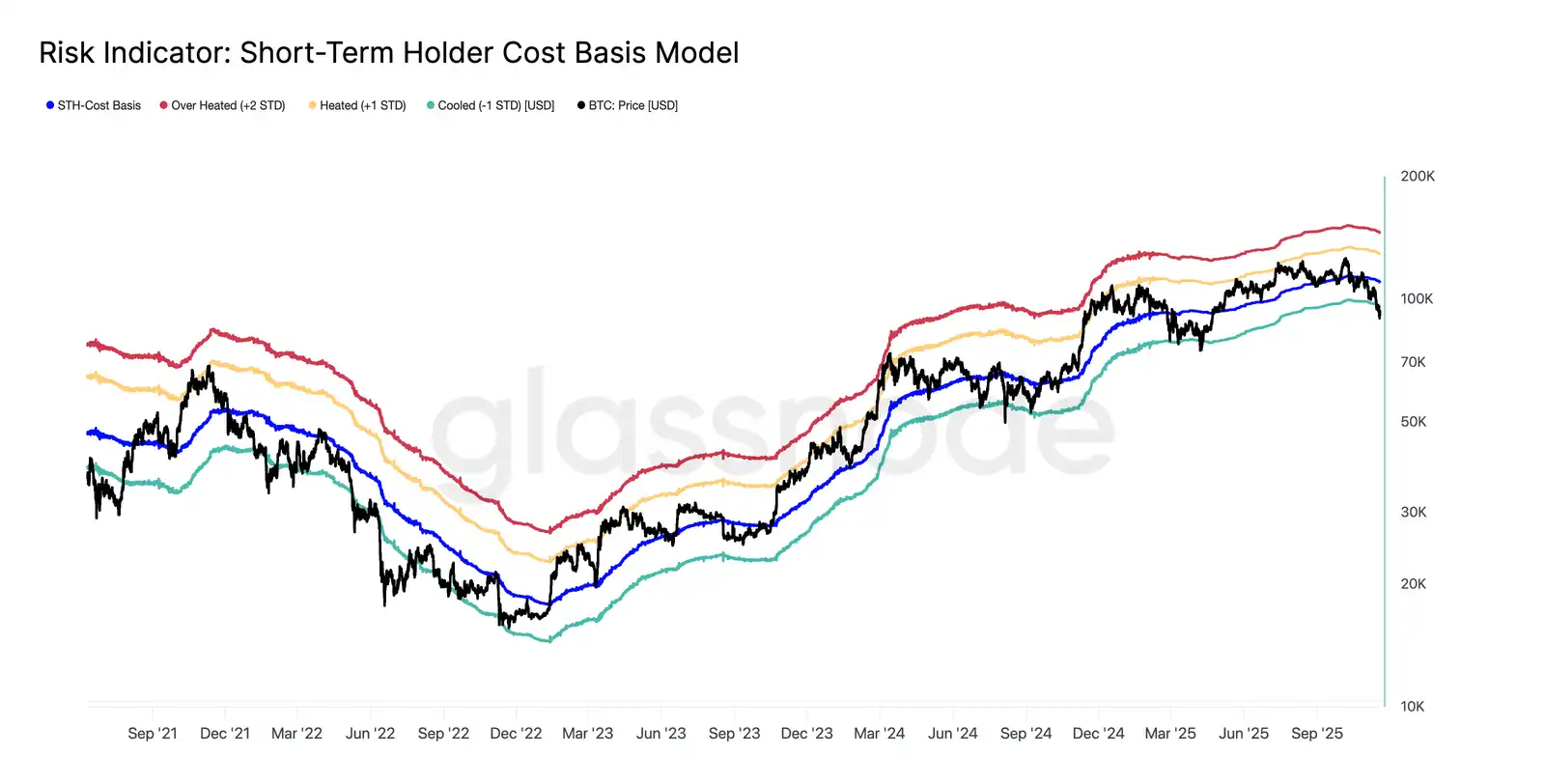
Panic Selling Peaks
From an investor behavior perspective, this crash marks the third time since the start of 2024 that the price has fallen below the lower limit of the short-term holder cost basis model. However, the level of panic among top buyers is clearly higher this time. The 7-day average of STH realized losses has soared to $523 million per day, the highest since the FTX collapse.
Such high realized losses highlight a much heavier top structure formed between $106,000 and $118,000, with a density far exceeding previous cycle peaks. This means that either much stronger demand is needed to absorb the BTC being sold, or the market will need a longer and deeper accumulation phase to restore balance.
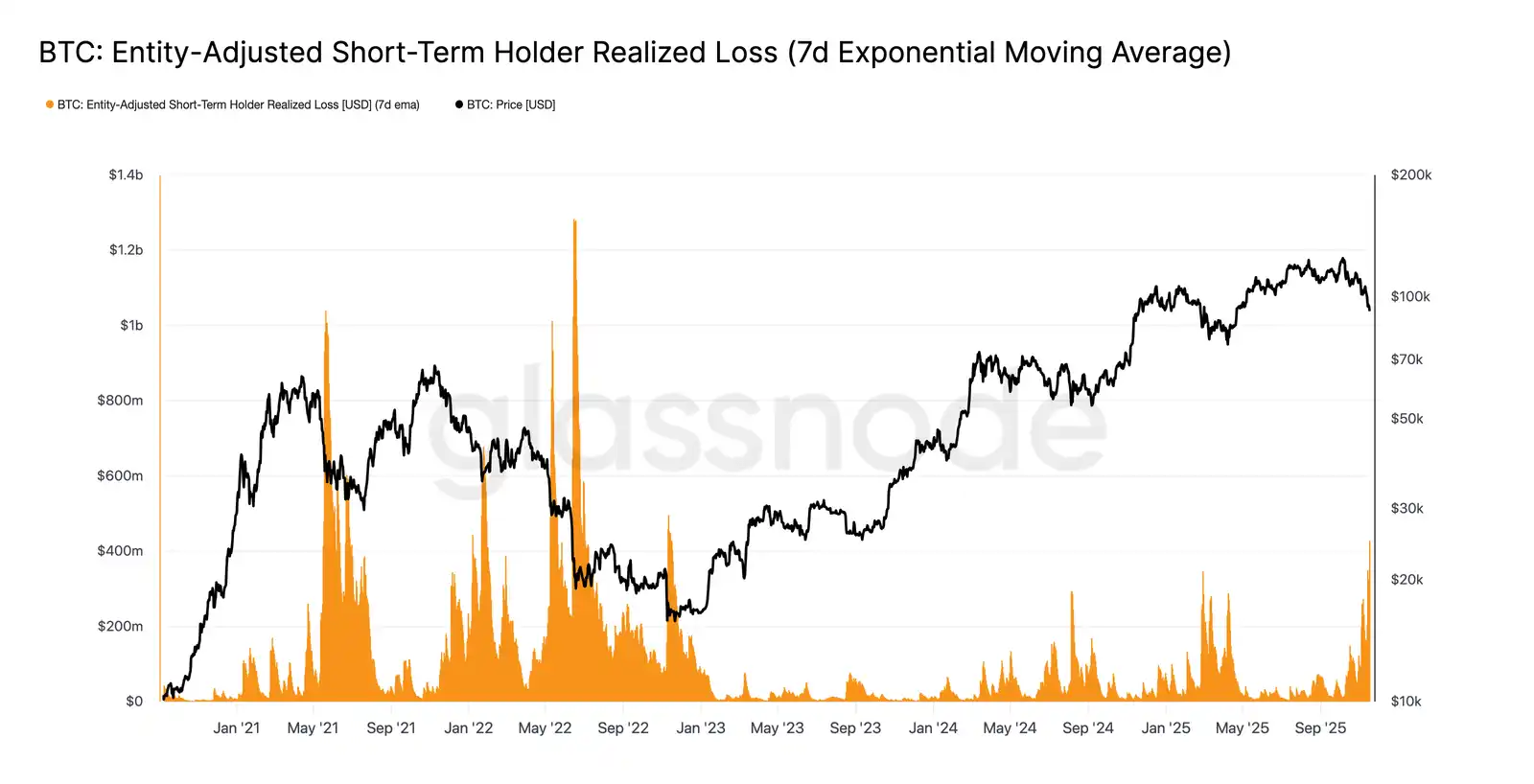
Testing Active Demand
Re-examining valuation models, the market has now entered uncharted territory, with speculative interest rising significantly during this mild bear phase. The first major defensive area is the Active Investors' Realized Price, currently around $88,600. Bitcoin trading near this level corresponds to the cost basis of non-dormant holders who have been actively trading in recent months, making it a potential mid-term trading range.
However, if the price decisively breaks below this model, it would mark the first time this cycle that the price has fallen below the cost basis of active investors, clearly indicating that bearish momentum is dominating the market.
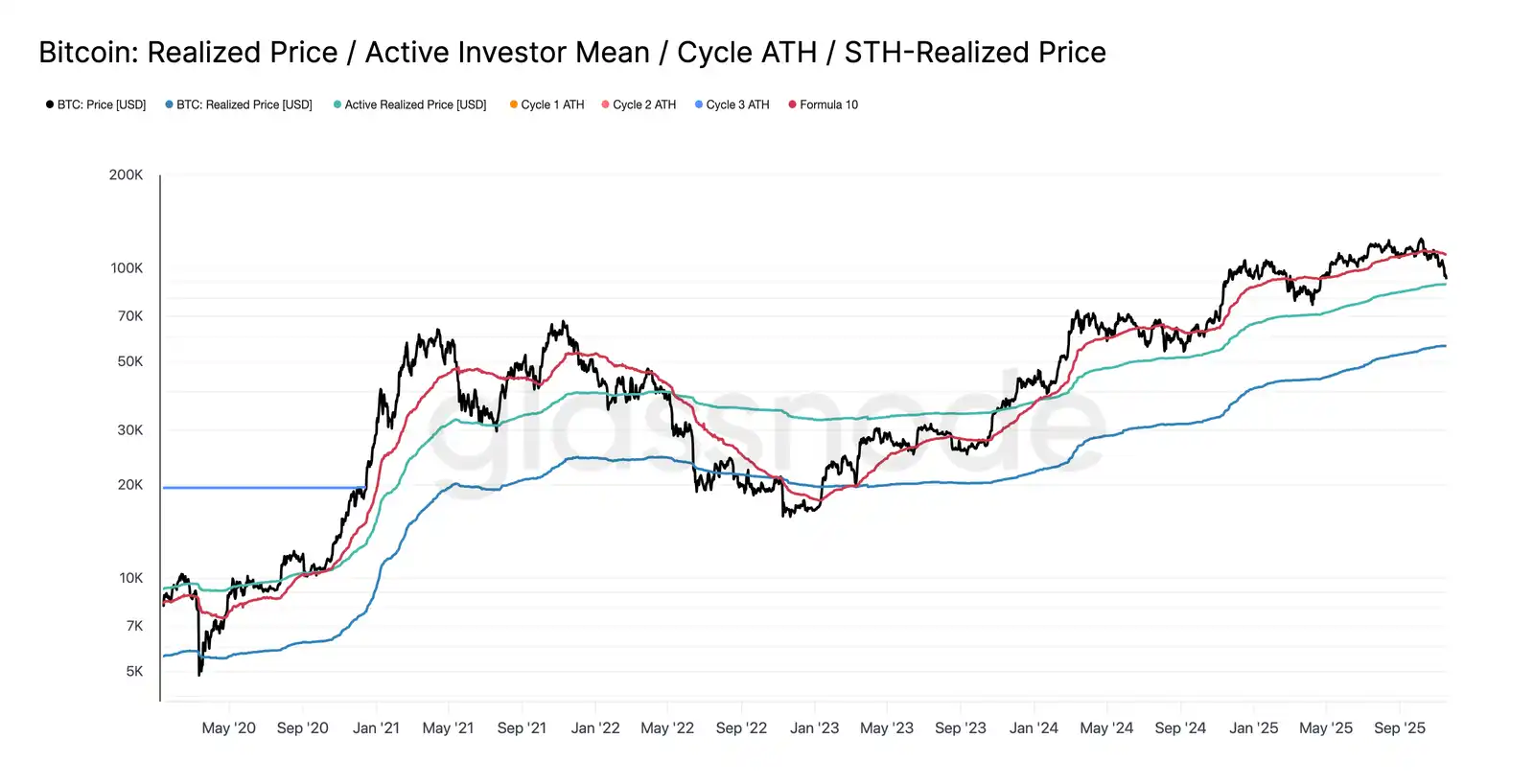
Another Form of Retreat
Although Bitcoin's price has broken below the main lower limit of the short-term holder cost basis model, the scale and degree of investor losses are far less extreme than during the 2022-2023 bear market. The chart below tracks all currently underwater cryptocurrencies, grouped by the depth of their unrealized drawdowns. Currently, about 6.3 million bitcoins are in a loss position, with most losses in the -10% to -23.6% range.
This distribution is more similar to the brief range-bound market of Q1 2022, rather than a deep capitulation phase.
Therefore, the price range between the Active Investors' Realized Price ($88,600) and the True Market Mean ($82,000) may serve as the dividing line between a mild bear phase and a full-blown bear market structure like 2022-2023.
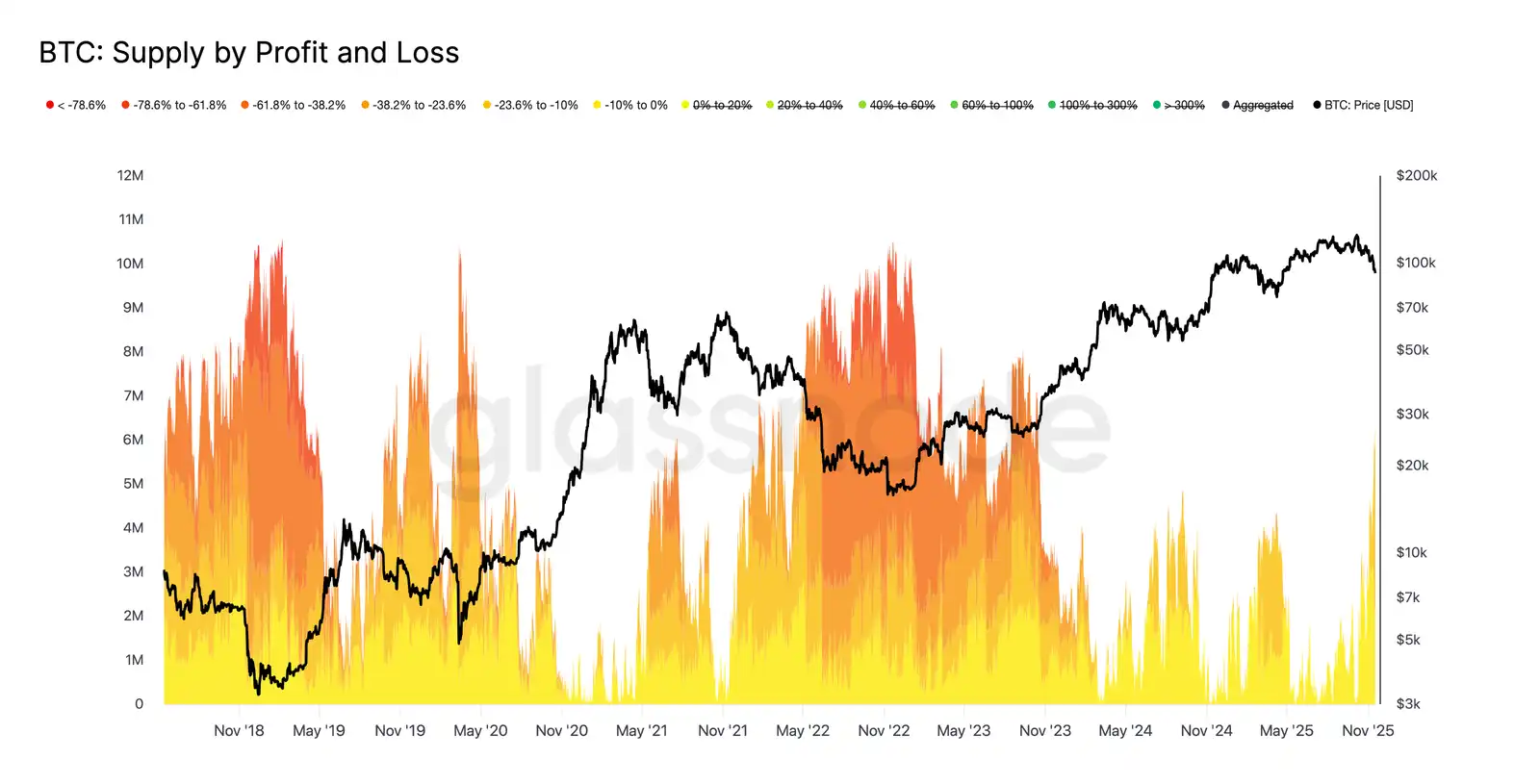
Off-Chain Insights
Insufficient ETF Demand
US spot ETF flows continue to reflect a clear lack of demand, with the 7-day average remaining negative in recent weeks. Ongoing outflows indicate that traditional financial asset allocators are unwilling to add during the current downturn, a stark contrast to the strong inflows that previously supported the market's rise. Persistent weakness suggests that non-discretionary investment demand has cooled significantly, highlighting the lack of new buying from one of the market's largest marginal buyer groups and further reinforcing the overall demand-constrained situation. The absence of sustained ETF inflows indicates that a key pillar of demand has not yet returned, leaving this cycle's market without a crucial source of demand.
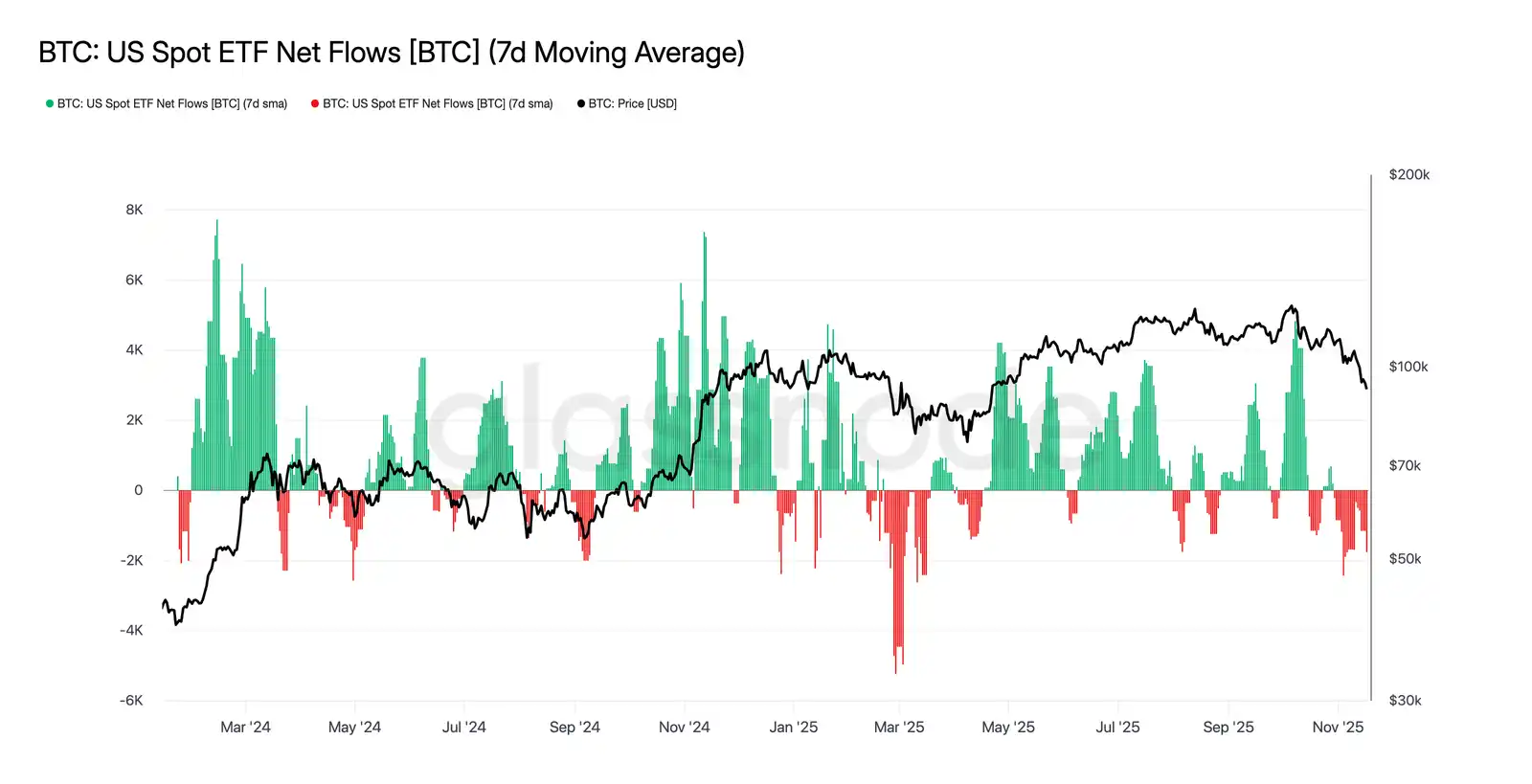
No Signs of Risk Appetite
This week's futures open interest continued to decline in tandem with price, indicating a sustained reduction in speculative activity. Traders are not buying the dip but are systematically closing positions, resulting in derivatives market positioning that is noticeably lower than previous downturns. The lack of leveraged expansion highlights market participants' caution and aligns with the broader trend of weakened risk appetite.
The ongoing contraction in futures positions underscores the market's continued reluctance to deploy capital, further exacerbating the lack of confidence behind current price action.
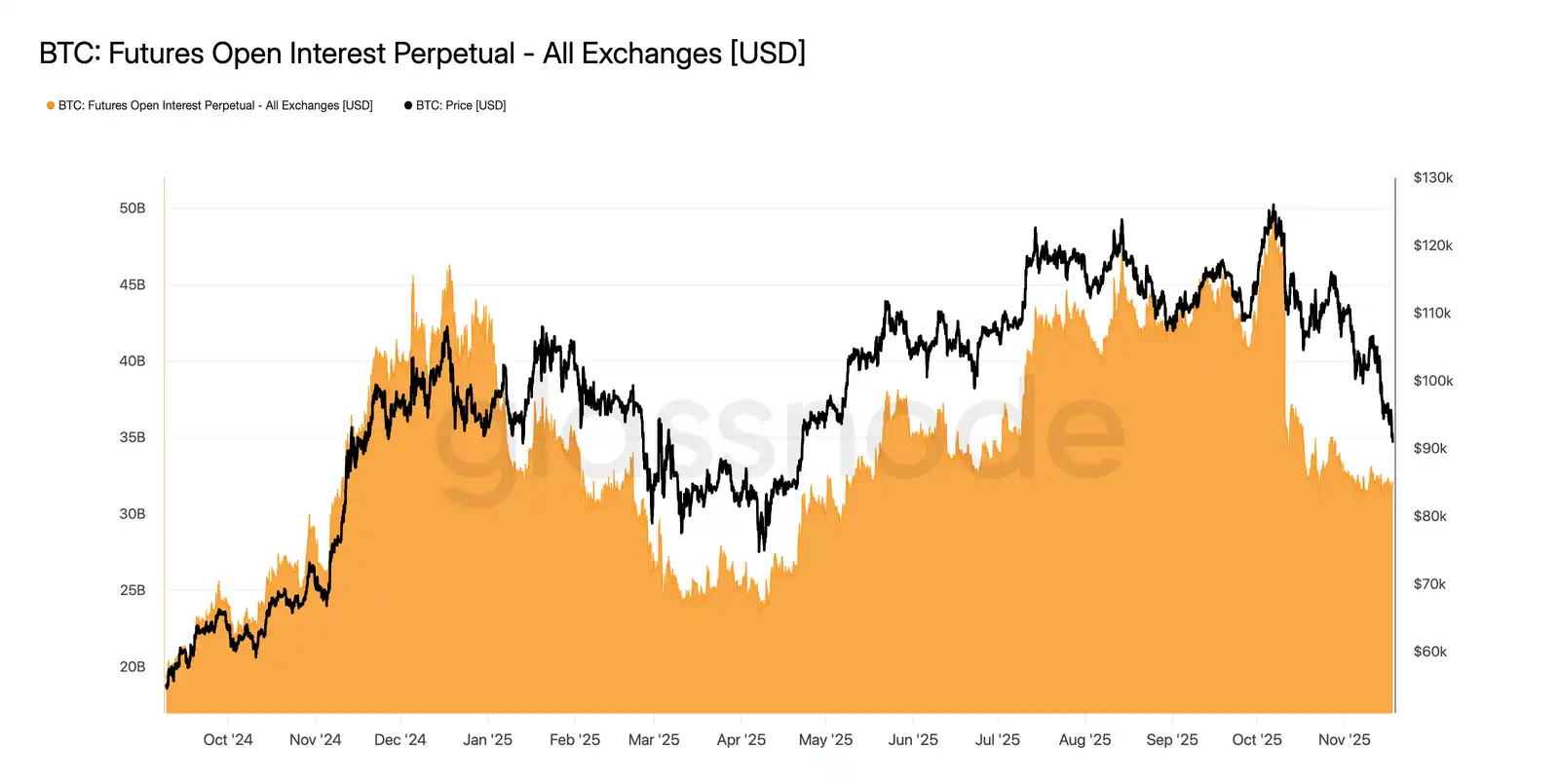
Funding Rates at Cycle Lows
As futures open interest continues to fall, the derivatives market is signaling a clear reduction in speculative positions. Traders are closing positions rather than buying the dip, resulting in leverage in open interest being significantly lower than previous declines.
This dynamic is also reflected in the funding market, where rates for the top 500 assets have clearly shifted to neutral or even negative territory. The previous positive premium environment has now turned negative, highlighting the broad cooling of leveraged long demand and a shift toward more defensive strategies.
The decline in open interest and negative funding together confirm that speculative leverage is being systematically withdrawn from the market, reinforcing risk-off sentiment.
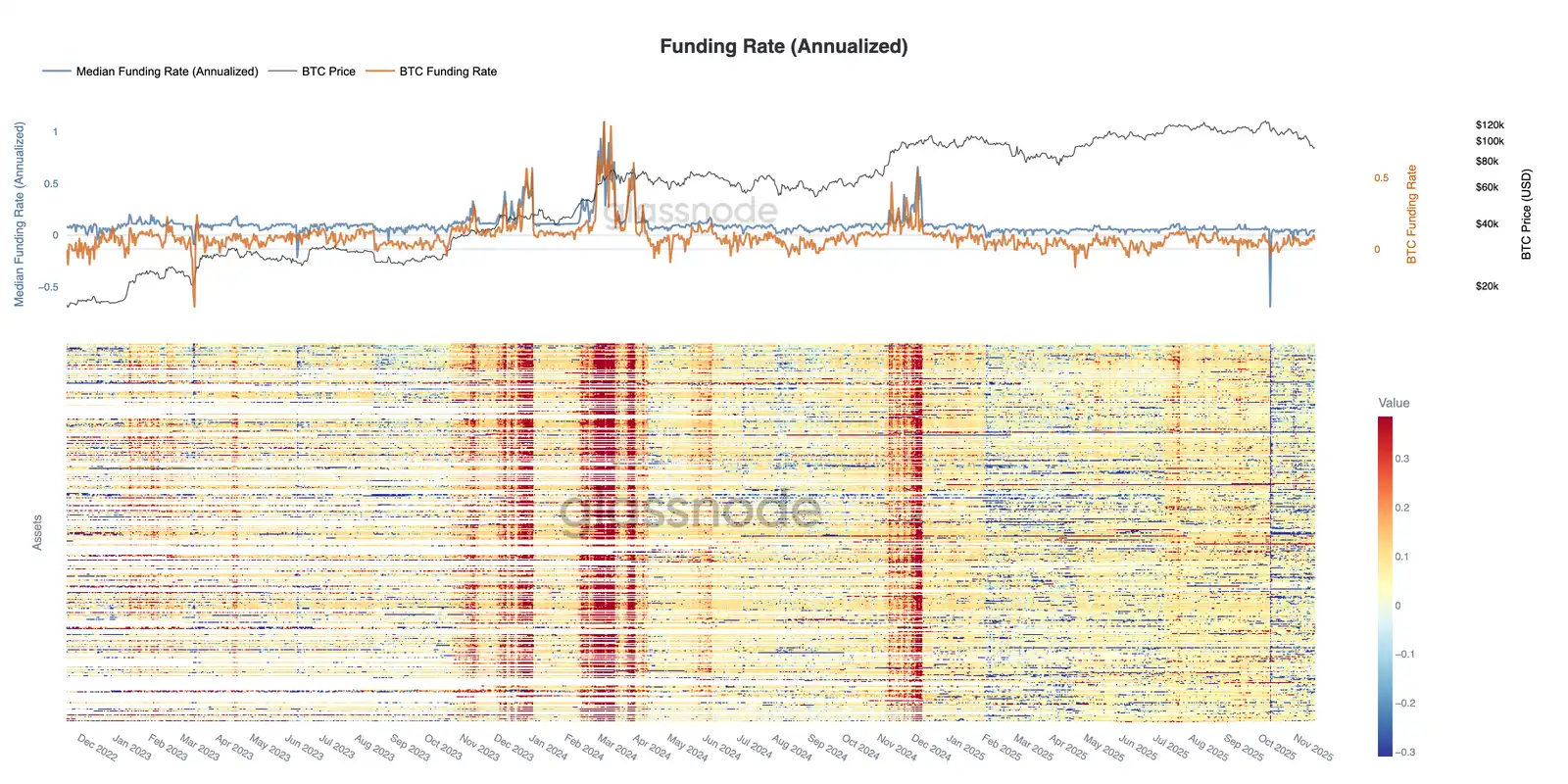
Implied Volatility Surges
The options market is typically the first to reprice risk, and after bitcoin briefly fell below $90,000, the options market quickly repriced risk. Implied volatility rose sharply across all tenors, with the strongest reaction in near-term options. The chart shows a clear rise in short-term option volatility, with broad repricing across the entire options curve.
This increase reflects two drivers. First, traders are preparing for the possibility of a larger correction, increasing demand for downside protection. Second, the response from short gamma trading desks. Many traders were forced to buy back short options and roll positions up, mechanically pushing up near-term implied volatility.
Implied volatility is now near levels seen during the October 11 liquidation event, indicating that traders have rapidly reassessed near-term risks.
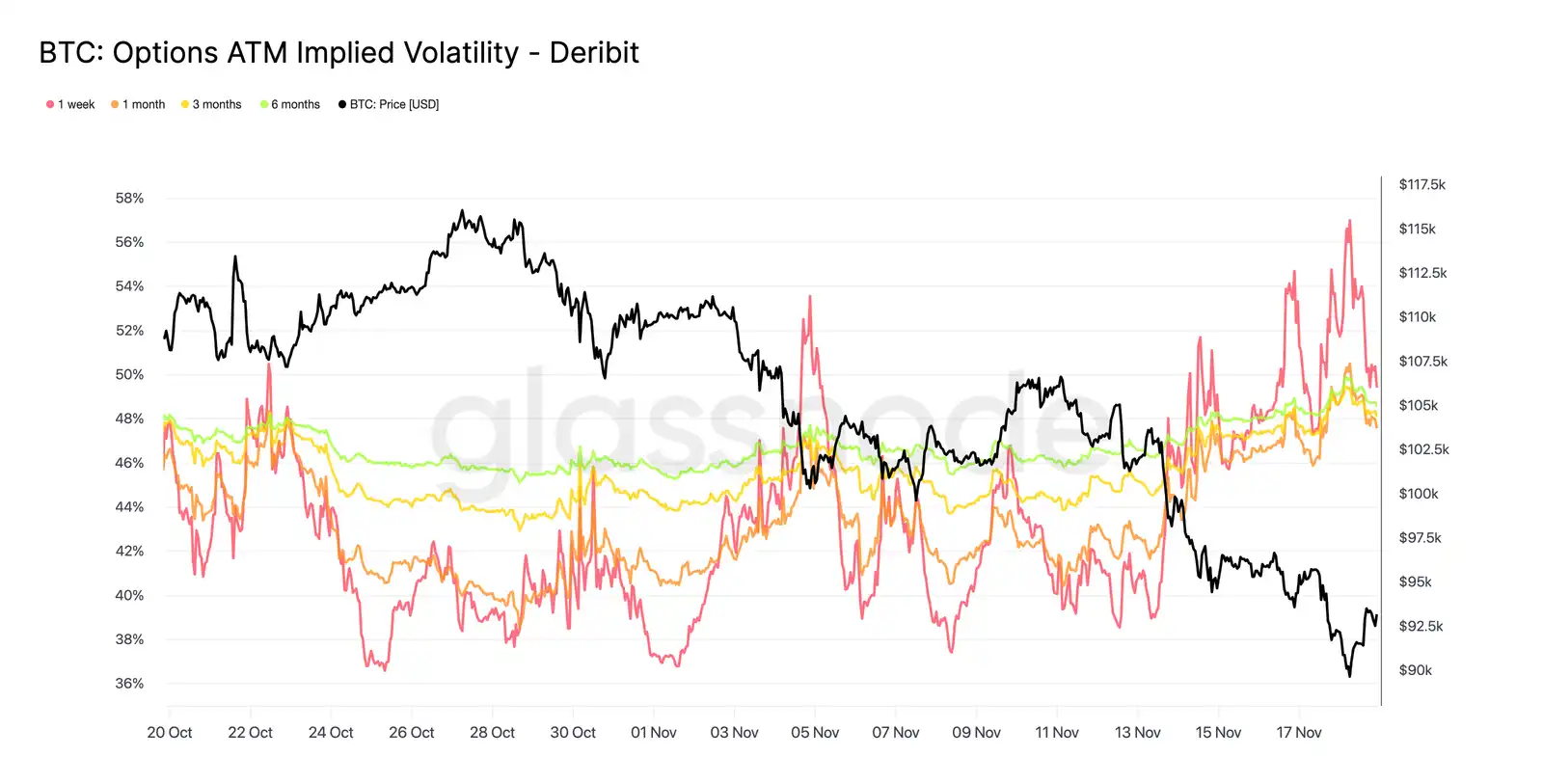
This Skew Confirms Market Concerns
Shifting from implied volatility to skew, the options market is sending the same message. The 25-delta skew remains negative across all tenors, with the one-week skew approaching extremely bearish levels. One-week put options are trading at a premium of about 14%, indicating that traders are willing to pay higher prices for downside protection regardless of spot price action.
This behavior can create a self-fulfilling prophecy. When traders buy these put options, dealers often end up holding short positions. To hedge this risk, they sell futures or perpetual contracts. This selling adds market pressure and can amplify the weakness traders are trying to hedge against.
The yield curve for longer-term bonds is also skewed bearish, but to a lesser extent. The six-month bond yield curve is just below 5%, indicating that market concerns are mainly focused on short-term bonds rather than the entire tenor range.
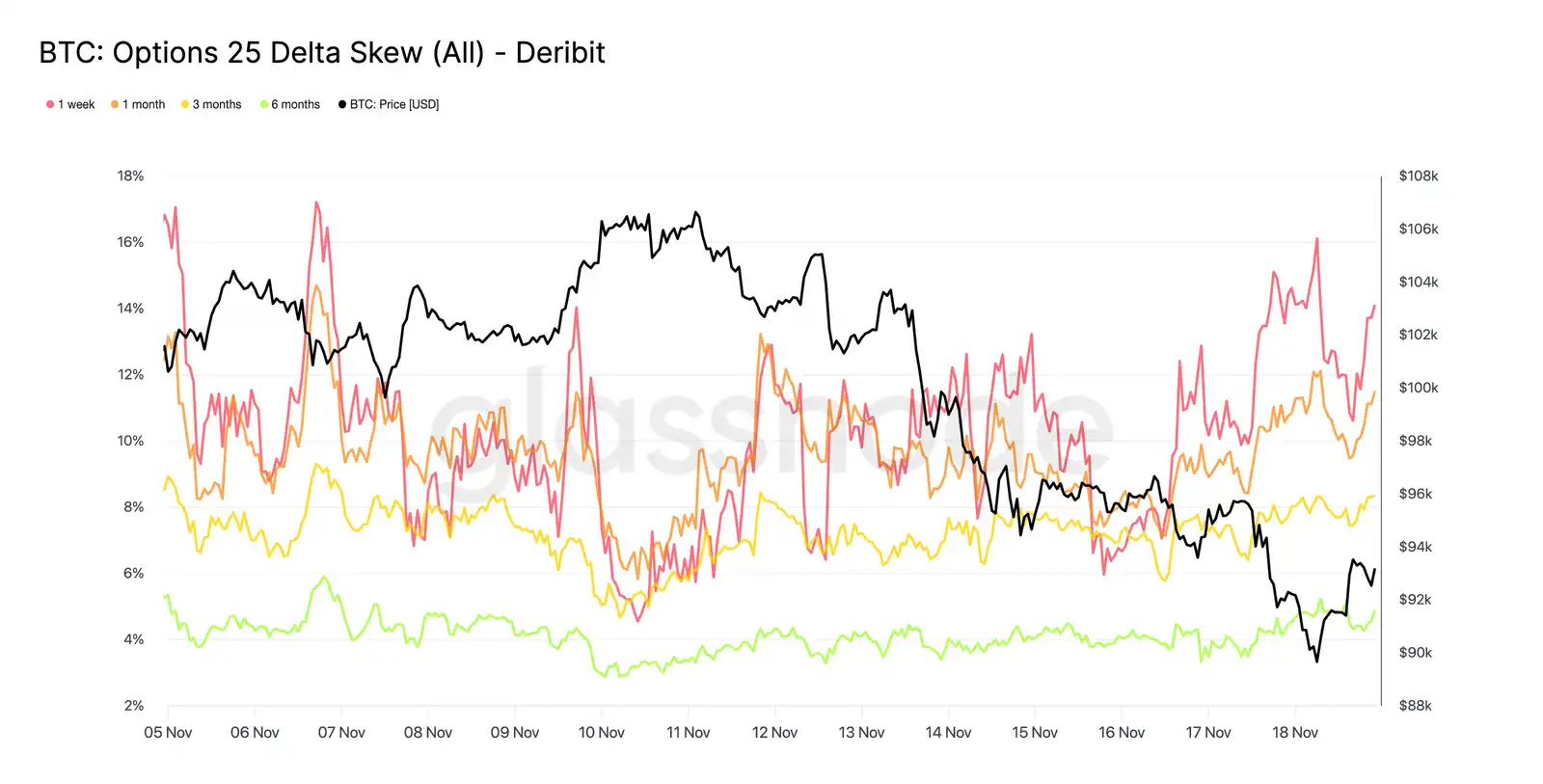
Demand for Downside Protection
From market skew to actual trading activity, the past seven days of trading flows confirm the same pattern. Traders have bought a large amount of put option premium, far exceeding demand for call options. This aligns with hedging behavior, reflecting a preference for guarding against further market declines rather than betting on a rally.
The subdued activity in call options further confirms that traders are not significantly increasing risk exposure before year-end. Compared to put flows, both buying and selling of calls remain low, supporting the view that caution, not speculation, is driving position changes.
Overall, this combination suggests the market is preparing for volatility and is more inclined toward protection than risk-taking.

90K Strike Option Premiums
Continuing the overall flow data, the put option premium at the 90K strike shows that as prices weaken, protective demand is accelerating. Over the past two weeks, the net put premium at this strike remained relatively balanced until bitcoin broke below the $93,000 mark. Once below this level, traders increased their selling of these puts, causing the 90K strike option premium to surge.
This behavior indicates that as spot pressure intensifies, traders are willing to pay increasingly higher prices for downside protection. This move also coincides with the earlier rise in short-term implied volatility, as concentrated demand at key strikes typically pushes up the price of near-term contracts on the curve.
The sharp repricing of 90K puts highlights how quickly downside hedging activity can accelerate when key price levels are breached.

Pricing Market Fragility
The DVOL index, shifting from individual option prices to a broader volatility indicator, reflects the degree of market repricing of risk. After approaching 40 three weeks ago, the DVOL index has rebounded to near its monthly high of 50. DVOL reflects the implied volatility of a basket of fixed-expiry options, so when the DVOL index rises, it indicates traders expect greater price swings ahead.
This rise ties together the overall trend in the options market. Implied volatility is up across all tenors, skew remains negative, recent delta flows are negative, and traders seem unwilling to add risk before year-end. These factors together suggest the market is preparing for significant price swings. Major drivers include liquidation risk in perpetual contracts, macroeconomic uncertainty, and weak spot demand due to ETF inflows.
The next event that could change this volatility regime is the Federal Open Market Committee (FOMC) meeting in three weeks. Until then, the options market will continue to send cautious signals and clearly indicate a preference for risk aversion.
The rise in DVOL further confirms that the market is digesting expectations of greater future volatility, and traders are preparing for market swings.
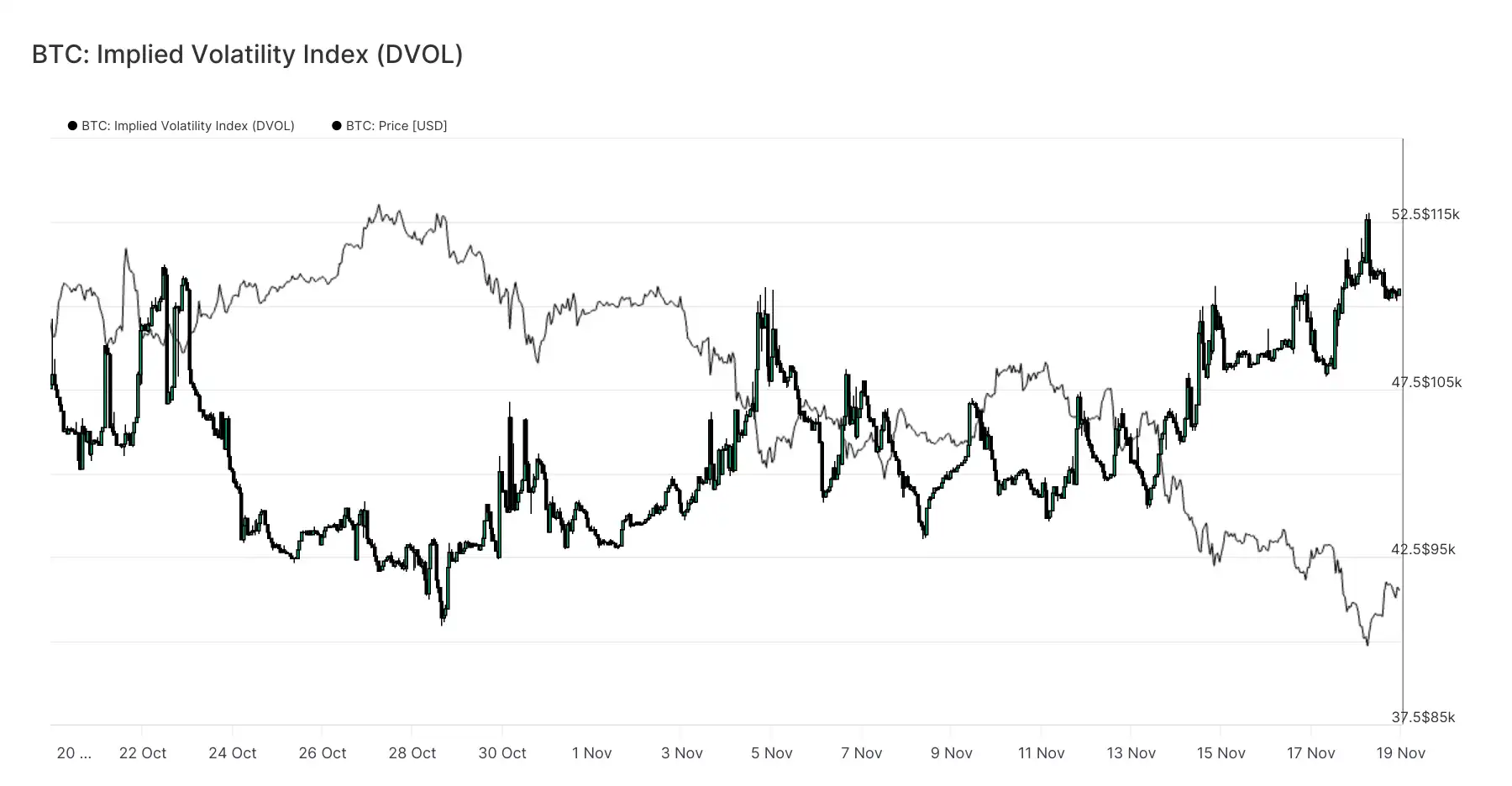
Conclusion
Bitcoin continues to experience a challenging market phase, characterized by weak market structure, shrinking speculative demand, and a significant rise in risk-off sentiment in the derivatives market.
Spot demand remains sluggish, ETF inflows are negative, and the futures market shows no intention of increasing leverage amid weakness.
Meanwhile, implied volatility, skew, and hedging flows all indicate that investors' concerns about near-term downside risk are intensifying, and they are paying increasingly high premiums for protection.
All these factors together form a market seeking stability, with its future direction depending on whether demand can re-emerge near key cost levels, or if current fragility will evolve into a deeper correction or bear market.